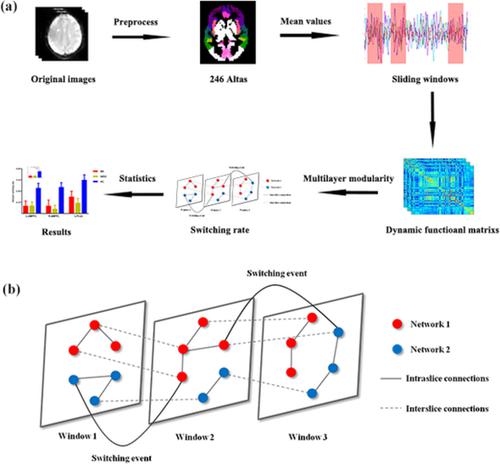当前位置:
X-MOL 学术
›
Hum. Brain Mapp.
›
论文详情
Our official English website, www.x-mol.net, welcomes your feedback! (Note: you will need to create a separate account there.)
Resting state functional network switching rate is differently altered in bipolar disorder and major depressive disorder.
Human Brain Mapping ( IF 4.8 ) Pub Date : 2020-05-13 , DOI: 10.1002/hbm.25017 Shaoqiang Han 1 , Qian Cui 2, 3 , Xiao Wang 1 , Liang Li 1 , Di Li 1 , Zongling He 1 , Xiaonan Guo 1 , Yun-Shuang Fan 1 , Jing Guo 1 , Wei Sheng 1 , Fengmei Lu 1 , Huafu Chen 1, 2
Human Brain Mapping ( IF 4.8 ) Pub Date : 2020-05-13 , DOI: 10.1002/hbm.25017 Shaoqiang Han 1 , Qian Cui 2, 3 , Xiao Wang 1 , Liang Li 1 , Di Li 1 , Zongling He 1 , Xiaonan Guo 1 , Yun-Shuang Fan 1 , Jing Guo 1 , Wei Sheng 1 , Fengmei Lu 1 , Huafu Chen 1, 2
Affiliation

|
The clinical misdiagnosis ratio of bipolar disorder (BD) patients to major depressive disorder (MDD) patients is high. Recent findings hypothesize that the ability to flexibly recruit functional neural networks is differently altered in BD and MDD patients. This study aimed to explore distinct aberrance of network flexibility during dynamic networks configuration in BD and MDD patients. Resting state functional magnetic resonance imaging of 40 BD patients, 61 MDD patients, and 61 matched healthy controls were recruited. Dynamic functional connectivity matrices for each subject were constructed with a sliding window method. Then, network switching rate of each node was calculated and compared among the three groups. BD and MDD patients shared decreased network switching rate of regions including left precuneus, bilateral parahippocampal gyrus, and bilateral dorsal medial prefrontal cortex. Apart from these regions, MDD patients presented specially decreased network switching rate in the bilateral anterior insula, left amygdala, and left striatum. Taken together, BD and MDD patients shared decreased network switching rate of key hubs in default mode network and MDD patients presented specially decreased switching rate in salience network and striatum. We found shared and distinct aberrance of network flexibility which revealed altered adaptive functions during dynamic networks configuration of BD and MDD.
中文翻译:

双相情感障碍和重度抑郁症的静息状态功能网络转换率有不同的改变。
双相情感障碍(BD)患者与重度抑郁症(MDD)患者的临床误诊率较高。最近的研究结果假设,双相情感障碍和重度抑郁症患者灵活招募功能神经网络的能力发生了不同的改变。本研究旨在探讨 BD 和 MDD 患者动态网络配置过程中网络灵活性的明显异常。招募了 40 名 BD 患者、61 名 MDD 患者和 61 名匹配的健康对照者的静息态功能磁共振成像。使用滑动窗口方法构建每个受试者的动态功能连接矩阵。然后,计算每个节点的网络切换率并在三组之间进行比较。BD 和 MDD 患者的左侧楔前叶、双侧海马旁回和双侧背内侧前额叶皮质等区域的网络切换率均降低。除这些区域外,MDD患者的双侧前岛叶、左侧杏仁核和左侧纹状体的网络转换率特别降低。总的来说,BD和MDD患者在默认模式网络中关键枢纽的网络切换率均降低,MDD患者在显着网络和纹状体中表现出特别降低的网络切换率。我们发现网络灵活性存在共同且独特的异常,这揭示了 BD 和 MDD 动态网络配置期间自适应功能的改变。
更新日期:2020-07-22
中文翻译:

双相情感障碍和重度抑郁症的静息状态功能网络转换率有不同的改变。
双相情感障碍(BD)患者与重度抑郁症(MDD)患者的临床误诊率较高。最近的研究结果假设,双相情感障碍和重度抑郁症患者灵活招募功能神经网络的能力发生了不同的改变。本研究旨在探讨 BD 和 MDD 患者动态网络配置过程中网络灵活性的明显异常。招募了 40 名 BD 患者、61 名 MDD 患者和 61 名匹配的健康对照者的静息态功能磁共振成像。使用滑动窗口方法构建每个受试者的动态功能连接矩阵。然后,计算每个节点的网络切换率并在三组之间进行比较。BD 和 MDD 患者的左侧楔前叶、双侧海马旁回和双侧背内侧前额叶皮质等区域的网络切换率均降低。除这些区域外,MDD患者的双侧前岛叶、左侧杏仁核和左侧纹状体的网络转换率特别降低。总的来说,BD和MDD患者在默认模式网络中关键枢纽的网络切换率均降低,MDD患者在显着网络和纹状体中表现出特别降低的网络切换率。我们发现网络灵活性存在共同且独特的异常,这揭示了 BD 和 MDD 动态网络配置期间自适应功能的改变。


























 京公网安备 11010802027423号
京公网安备 11010802027423号